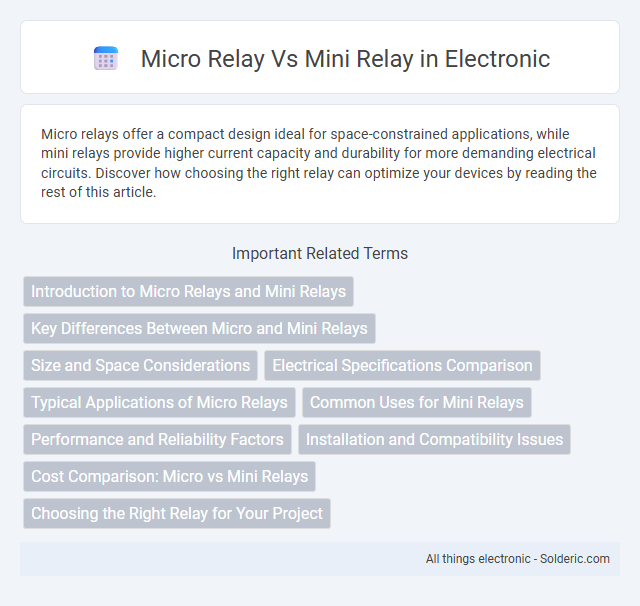Micro relays offer a compact design ideal for space-constrained applications, while mini relays provide higher current capacity and durability for more demanding electrical circuits. Discover how choosing the right relay can optimize your devices by reading the rest of this article.
Comparison Table
| Feature | Micro Relay | Mini Relay |
|---|---|---|
| Size | Typically smaller, compact footprint (approx. 10x10x10 mm) | Larger than micro, moderate size (approx. 15x15x15 mm) |
| Current Rating | Low to moderate current loads (up to 10A) | Higher current handling (up to 20A or more) |
| Coil Voltage | Commonly 3V to 24V DC coil voltage | Often supports 5V to 48V DC coil voltage |
| Applications | Used in compact electronics, signal switching, low power control | Used in automotive, industrial control, moderate power switching |
| Contact Configuration | Usually SPDT or DPDT contacts | Typically SPDT, DPDT, and more complex options |
| Durability | Lower mechanical and electrical life (around 100,000 cycles) | Higher durability and longer life (up to 1,000,000 cycles) |
| Price | Generally less expensive | Moderate pricing due to higher specs |
Introduction to Micro Relays and Mini Relays
Micro relays and mini relays are compact electromechanical switches designed for low to medium power applications, distinguished primarily by their size and load capacity. Micro relays generally offer smaller physical dimensions and faster switching speeds, making them ideal for precision control in tight spaces. Mini relays provide a balance between compact size and higher current handling, commonly used in automotive, industrial control, and household appliances where moderate power switching is required.
Key Differences Between Micro and Mini Relays
Micro relays are typically smaller in size with lower current and voltage ratings, making them ideal for compact electronic devices and circuits requiring minimal space, whereas mini relays are larger, designed to handle higher power loads and provide greater mechanical durability. Micro relays usually have coil voltages ranging from 5V to 12V and contact ratings around 5A, while mini relays often support coil voltages up to 24V and contact ratings exceeding 10A. The choice between micro and mini relays largely depends on the application's space constraints and electrical power requirements.
Size and Space Considerations
Micro relays offer a significantly smaller footprint compared to mini relays, making them ideal for applications where space is at a premium, such as compact electronic devices or tight control panels. Their reduced size allows for higher density installations, enabling more relays to fit into limited spaces without sacrificing performance. If your project requires maximizing available space without compromising on relay functionality, micro relays are a superior choice.
Electrical Specifications Comparison
Micro relays typically operate at lower current ratings, around 5 to 10 amps, and voltage parameters generally up to 30V DC or 250V AC, making them ideal for compact electronic circuits with limited space. Mini relays support higher electrical loads, ranging from 10 to 30 amps, and accommodate higher voltage levels, often up to 125V DC or 250V AC, suitable for automotive and industrial applications demanding robust switching. Your choice between micro and mini relays should consider the specific current and voltage requirements of your electrical system for optimal performance and durability.
Typical Applications of Micro Relays
Micro relays are widely used in telecommunications equipment, automotive electronics, and medical devices due to their compact size and precise switching capabilities. Their small footprint and reliable performance make them ideal for applications requiring high-density circuit designs and low power consumption. Common uses include signal switching, control logic circuits, and power management in compact electronic systems.
Common Uses for Mini Relays
Mini relays are widely used in automotive applications, home appliances, and industrial control systems due to their compact size and reliable switching capabilities. Their versatility makes them ideal for controlling lights, motors, and heating elements in tight spaces where larger relays would be impractical. You can find mini relays frequently integrated into HVAC equipment, security systems, and consumer electronics for efficient and precise operation.
Performance and Reliability Factors
Micro relays offer compact designs with precise switching capabilities, making them ideal for applications requiring high-speed operation and low power consumption. Mini relays typically provide greater current handling and enhanced durability, suitable for automotive and industrial environments where robustness is critical. Performance and reliability depend on factors like coil voltage, contact material, and mechanical endurance, with micro relays excelling in low-load precision tasks and mini relays favored for heavy-duty, long-lasting use.
Installation and Compatibility Issues
Micro relays offer compact designs ideal for tight installation spaces, while mini relays provide slightly larger footprints that may be easier to handle in standard relay sockets. Compatibility issues often arise because micro relays typically require specialized sockets or mounting options, whereas mini relays fit established DIN rail or PCB configurations. You should verify the socket type and electrical specifications to ensure seamless installation and avoid functionality problems.
Cost Comparison: Micro vs Mini Relays
Micro relays generally offer a lower cost compared to mini relays due to their smaller size and simpler design, making them ideal for budget-sensitive applications. Mini relays provide higher current ratings and enhanced durability, which can increase their price but justify the investment in more demanding environments. The cost difference between micro and mini relays is often offset by the specific electrical and mechanical requirements of the application, emphasizing the need for careful evaluation of performance versus price.
Choosing the Right Relay for Your Project
Selecting the right relay for your project depends on factors like size constraints, switching capacity, and application requirements. Micro relays offer compact size and low power consumption, ideal for space-limited electronics, while mini relays provide higher current ratings suitable for industrial or automotive uses. Understanding your electrical load and available space ensures you pick a relay that optimizes performance and reliability.
Micro relay vs mini relay Infographic

 solderic.com
solderic.com